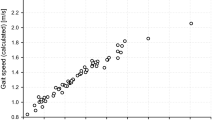Abstract
Activity monitors based on accelerometry are used to predict the speed and energy cost of walking at 0% slope, but not at other inclinations. Parallel measurements of body accelerations and altitude variation were studied to determine whether walking speed prediction could be improved. Fourteen subjects walked twice along a 1.3km circuit with substantial slope variations (−17% to +17%). The parameters recorded were body acceleration using a uni-axial accelerometer, altitude variation using differential barometry, and walking speed using satellite positioning (DGPS). Linear regressions were calculated between acceleration and walking speed, and between acceleration/altitude and walking speed. These predictive models, calculated using the data from the first circuit run, were used to predict speed during the second circuit. Finally the predicted velocity was compared with the measured one. The result was that acceleration alone failed to predict speed (meanr=0.4). Adding altitude variation improved the prediction (meanr=0.7). With regard to the altitude/acceleration-speed relationship, substantial inter-individual variation was found. It is concluded that accelerometry, combined with altitude measurement, can assess position variations of humans provided inter-individual variation is taken into account. It is also confirmed that DGPS can be used for outdoor walking speed measurements, opening up new perspectives in the field of biomechanics.
Similar content being viewed by others
References
Almeras, N., Mimeault, N., Serresse, O., Boulay M. R., andTremblay, A. (1991): ‘Non-exercise daily energy expenditure and physical activity pattern in male endurance athletes’,Eur. J. Appl. Physiol.,63, pp. 184–187
Balogun, J. A., Martin, D. A., andClendenin, M. A. (1989): ‘Calorimetric validation of the Caltrac accelerometer during level walking’,Phys Ther.,69, pp. 501–509
Bianchi, L., Angelini, D., andLacquaniti, F. (1998): ‘Individual characteristics of human walking mechanics’,Pflugers Arch.,436 pp. 343–356
Bobbert, A. C. (1960): ‘Energy expenditure in level and grade walking’,J. Appl. Physiol.,15, pp. 1015–1021
Eston, R. G., Rowlands, A. V., andIngledew, D. K. (1998): ‘Validity of heart rate, pedometry, and accelerometry for predicting the energy cost of children's activities’,J. Appl. Physiol.,84, pp. 362–371
Hakim, A. A., Petrovitch, H., Burchfiel, C. M., Ross, G. W., Rodriguez, B. L., White, L. R., Yano, K., Curb, J. D., andAbbott, R. D. (1998): ‘Effects of walking on mortality among nonsmoking retired men’,New England J. Med.,338, pp. 94–99
Leick, A. (1995): ‘Satellite surveying’, 2nd Edn (Wiley-Interscience, John Wiley & Sons Inc., New York)
Meijer, G. A., Westerterp, K. R., Koper, H., andTen Hoor, F. (1989): ‘Assessment of energy expenditure by recording heart rate and body acceleration’,Med. Sci. Sports Exerc.,21, pp. 343–347
Melanson, E. L. Jr., andFreedson, P. S. (1995): ‘Validity of the Computer Science and Applications, Inc. (CSA) activity monitor’,Med. Sci. Sports Exerc.,27, pp. 934–940
Minetti, A. E. (1995): ‘Optimum gradient of mountain paths’,J. Appl. Physiol.,79, pp. 1698–1703
Montoye, H. J., Washburn, R., Servais, S., Ertl, A., Webster, J. G., andNagle, F. J. (1983): ‘Estimation of energy expenditure by a portable accelerometer’,Med. Sci. Sports Exerc.,15, pp. 403–407
Pate, R. R., Pratt, M., Blair, S. N., Haskell, W. L., Macera, C. A., Bouchard, C., Buchner, D., Ettinger, W., Heath, G. W., King, A. C. (1995): ‘Physical activity and public health: a recommendation from the Centers for Disease Control and Prevention and the American College of Sports Medicine’,J. Am. Med. Assoc.,273, pp. 402–407
Perrin, O. (1999): ‘Integration de mesures satellitaires et barométriques pour la localisation 3D’,Mensuration, Photogrammétrie, Génie rural,6/99, pp. 320–323
Pivarnik, J. M., andSherman, N. W. (1990): ‘Responses of aerobically fit men and women to uphill/downhill walking and slow jogging’,Med. Sci. Sports Exerc.,22, pp. 127–130
Schutz, Y., andChambaz, A. (1997): ‘Could a satellite-based navigation system (GPS) be used to assess the physical activity of individuals on earth?’Eur. J. Clin. Nutr.,51, pp. 338–339.
Schutz, Y., andDeurenberg, P. (1996): ‘Energy metabolism: overview of recent methods used in human studies’,Ann. Nutr. Metab.,40, pp. 83–93
Sun, J., Walters, M., Svensson, N., andLloyd, D. (1996): ‘The influence of surface slope on human gait characteristics: a study of urban pedestrians walking on an inclined surface’,Ergonomics,39, pp. 677–692
Terrier, P., Aminian, K., andSchutz, Y. (1999): ‘Can accelerometry accurately predict energetic cost of walking in uphill and downhill conditions?’,Int. J. Obes. Relat Metab. Disord.,23, Suppl 5, p. S60
Author information
Authors and Affiliations
Corresponding author
Rights and permissions
About this article
Cite this article
Perrin, O., Terrier, P., Ladetto, Q. et al. Improvement of walking speed prediction by accelerometry and altimetry, validated by satellite positioning. Med. Biol. Eng. Comput. 38, 164–168 (2000). https://doi.org/10.1007/BF02344771
Received:
Accepted:
Issue Date:
DOI: https://doi.org/10.1007/BF02344771




